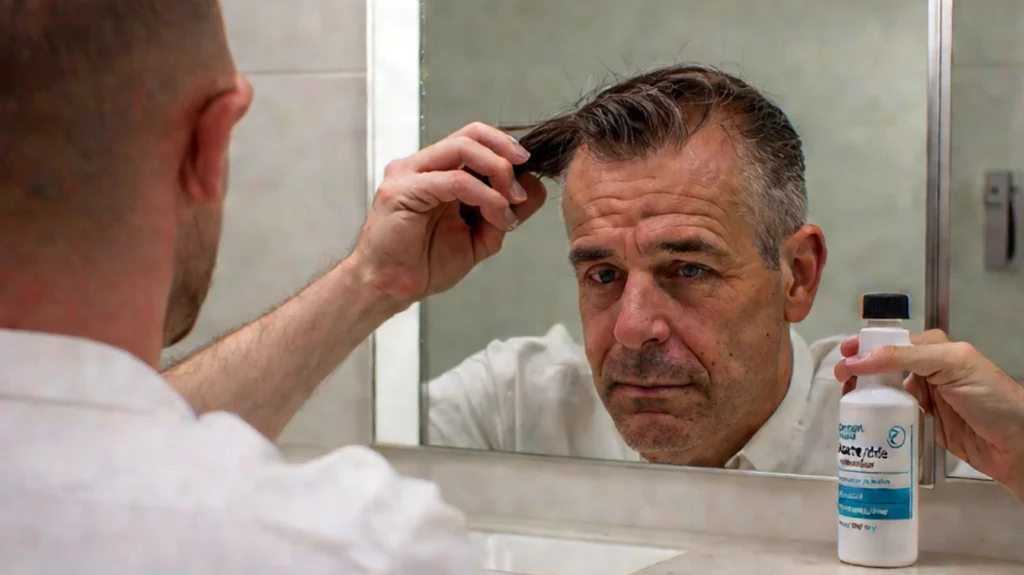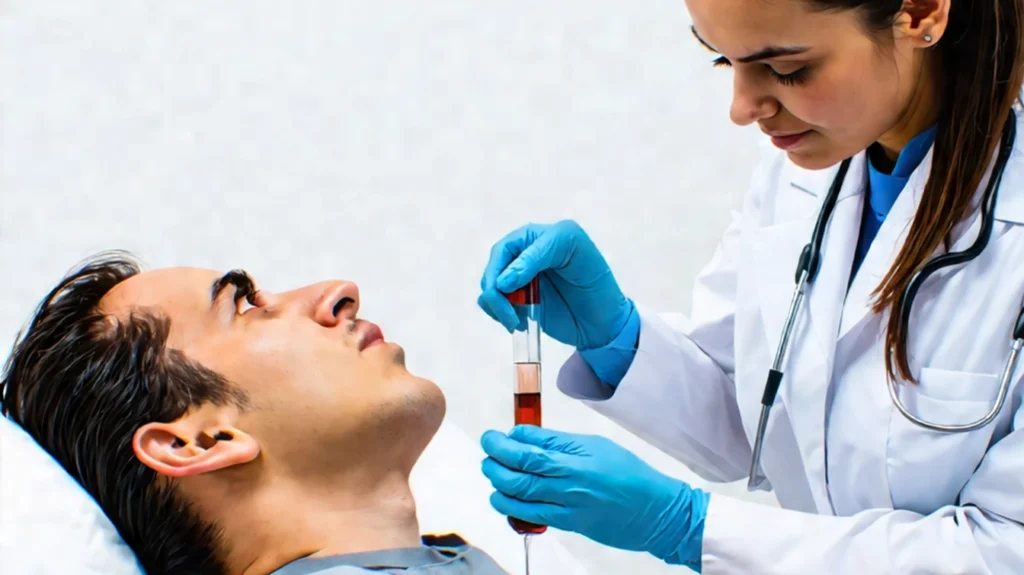Hair loss is a common concern for both men and women, often caused by factors like vitamin deficiencies or underlying conditions. Understanding the causes of hair loss can help identify effective treatments, such as PRP therapy, finasteride, and targeted vitamins, to promote healthier and stronger hair.
Understanding what causes hair loss, the associated symptoms, and your options for treatment is the first step to regaining confidence. From pinpointing which vitamin deficiencies cause hair loss to exploring solutions like finasteride or PRP therapy for hair loss, there are effective ways to address it. You’ll learn how proper care, medication, and even dietary adjustments can make a difference.
If you’re ready to explore options, it’s worth browsing resources like Hair loss Archives for insights into available treatments.
For a visual guide to causes and treatments, don’t miss this helpful video that explains your options clearly.
What Causes Hair Loss?
Hair loss isn’t just about aging—it’s a multifaceted issue influenced by genetics, certain medical conditions, and everyday lifestyle choices. Understanding what leads to hair loss is crucial for identifying the right treatment options. Below, we break it down into the primary causes of hair loss that might be affecting your hair health. Whether it’s genetics, hormonal imbalances, stress, or lifestyle choices, pinpointing the root cause of hair loss can guide you toward effective solutions.
Genetic Factors
One of the most common causes of hair loss is androgenetic alopecia, also known as male or female pattern baldness. If your parents or relatives had thinning hair, you’re more likely to experience it as well. This hereditary condition is linked to hormonal imbalances and can start as early as your teens, progressing gradually over time.
For men, this typically shows up as a receding hairline or bald spots on the crown. For women, the hair tends to thin across the scalp, which can feel less obvious but no less distressing. Although androgenetic alopecia is permanent, early intervention and medications like finasteride may help slow the process and manage hair loss effectively. Looking for treatment ideas ?
Medical Conditions and Hormonal Imbalances
Hair health is closely tied to your overall health. Certain medical conditions and hormonal fluctuations can take a toll on your hair. For example, alopecia areata is an autoimmune disorder where the body attacks hair follicles, leading to patchy bald spots.
Hormonal changes during pregnancy often cause thicker hair due to increased estrogen, but post-pregnancy hormone shifts can result in sudden, noticeable shedding. Thyroid problems, whether hyperactive or underactive, can also disrupt natural hair growth cycles, thinning hair over time. Conditions like these highlight the need for tailored treatments and, sometimes, temporary dietary adjustments.
Lifestyle and Environmental Contributors
Have you ever considered how your daily habits affect your hair? From the food on your plate to the way you style your hair, the choices you make can lead to thinning or damage. Common lifestyle reasons for hair loss include:
- Tight hairstyles: Braids, buns, or ponytails that constantly pull on the scalp can cause a condition called traction alopecia.
- Chronic stress: Too much stress can disrupt your hair growth cycle, often causing a temporary condition called telogen effluvium.
- Poor diet: Nutritional deficiencies, especially in vitamins like biotin and iron, can contribute to hair loss by weakening hair structure. Curious about which vitamins can help prevent hair loss ?
- Inadequate hair care: Overusing heat tools, harsh treatments, or even frequent bleaching damages the fragile hair cuticle.
All these factors combined reinforce the importance of a holistic hair care routine. Treating your hair gently and maintaining a balanced lifestyle can work wonders in keeping hair loss at bay.
Symptoms of Hair Loss
Hair loss can look different depending on the underlying cause, making it crucial to recognize potential warning signs early. Whether you’re noticing gradual changes over time or sudden, dramatic shedding, identifying symptoms accurately can help in pinpointing the source and managing the condition effectively.
Gradual Thinning
One of the most common symptoms of hair loss is gradual thinning, which often develops subtly over several years. For men, this type of hair loss primarily targets the crown of the head, leading to a receding hairline or noticeable thinning at the vertex. For women, thinning tends to affect the entire scalp rather than specific areas. Women may notice their hair part widening or the volume simply fading over time, sometimes to the point of exposing the scalp. Think of it like a well-loved sweater—over time, the fabric just doesn’t hold the same density.
Patchy or Sudden Hair Loss
Not everyone experiences hair loss gradually. Some individuals lose hair in distinctive round or oval patches, a condition often linked to alopecia areata. This autoimmune disorder prompts your immune system to attack hair follicles, leading to sudden bald spots, most commonly on the scalp but also eyebrows or lashes. You might wake up one day noticing a small patch that was filled with hair the day before.
On the other hand, drastic stressors to the body, such as illness, surgery, or even chronic stress, can trigger sudden shedding. This type of hair loss, known as telogen effluvium, doesn’t leave patches but can cause alarming clumps of hair to fall out when combing or washing.
Scaling and Inflammation
Sometimes hair loss is accompanied by additional scalp symptoms. Scaling, redness, or inflammation of the scalp may indicate an underlying condition like seborrheic dermatitis, psoriasis, or a fungal infection. These issues can weaken hair follicles over time, preventing hair from growing back. Think of it like a plant struggling to root in rocky soil—it’s the environment, not the plant itself, that’s the problem.
If you suspect scaling or fungal infections may be contributing factors, consult a healthcare provider for tailored recommendations. Addressing these conditions promptly is key to restoring a healthy scalp.
Hair loss symptoms can vary widely, but recognizing the signs early is essential for finding the right treatment path.
Popular Hair Loss Treatments
When it comes to tackling hair loss, the key is finding the right solution for your unique situation. With advancements in science and medicine, there’s a range of treatments available, from over-the-counter remedies to surgical interventions. Here’s an in-depth look into the most popular hair loss treatments and how they work.
Topical Treatments: Minoxidil
Minoxidil, commonly known by brand names like Rogaine, is a well-established treatment for both men and women experiencing hair loss. Here’s what makes it popular:
- How it Works: Minoxidil revitalizes shrunken hair follicles, prolonging their growth phase. It’s applied directly to the scalp, targeting specific areas of thinning or baldness.
- Effectiveness: Research shows that consistent application can slow down hair loss and, in some cases, stimulate regrowth. It’s particularly effective for early-stage male and female pattern baldness.
- Accessibility: Minoxidil is available over-the-counter in liquid, foam, or shampoo forms, making it an easy and cost-effective option for many.
However, continued use is necessary to maintain results, and some users may experience side effects like irritation or unwanted hair growth on other parts of the body.
Oral Medications for Hair Loss – Finasteride
Finasteride for hair loss is a game-changer for many men dealing with androgenetic alopecia, also known as male pattern baldness. Here’s what you should know:

- Mechanism: Finasteride works by inhibiting the production of DHT, a hormone directly linked to hair loss and hair follicle shrinkage. By blocking DHT, it helps preserve hair volume and, in some cases, encourages regrowth.
- Limitations: While highly effective for men, finasteride isn’t recommended for women, especially those who are pregnant or planning to conceive, as it may cause hormonal interference and potentially worsen hair loss in certain cases.
- Usage Precautions: Finasteride should be taken under medical supervision, as improper use or overdosage can lead to side effects such as decreased libido, erectile dysfunction, mood changes, and potentially worsened hair loss if mismanaged. Regular follow-ups with a healthcare provider are essential to ensure safe and effective use for hair loss treatment.
- Delayed Results: Finasteride requires consistent usage over several months to show noticeable effects in reducing hair loss. Results may vary among individuals, and stopping the medication can lead to a reversal of its benefits, potentially resulting in the recurrence of hair loss over time.
Finasteride requires a prescription and, like Minoxidil, needs to be taken continuously to sustain its benefits in managing hair loss. Stopping the treatment may lead to the resumption of hair loss over time. Common side effects include decreased libido and, rarely, prostate-specific concerns in some users.
Platelet-Rich Plasma (PRP) Therapy for Hair Loss
If you’re searching for an innovative option, PRP therapy for hair loss is gaining traction. This therapy uses your body’s own healing mechanisms to boost hair regrowth:

- How It Works: In PRP Therapy, a small sample of your blood is taken and spun in a centrifuge to isolate platelets, which are then used to address hair loss by promoting the regeneration of hair follicles and encouraging hair growth.
- Benefits: PRP therapy is a minimally invasive procedure with promising results for early hair loss stages. It’s safe, as it uses your own blood, and sessions typically take less than an hour with no significant downtime.
- Causes: Hair loss caused by stress, nutritional deficiencies, or hormonal imbalances may also respond well to PRP therapy, helping to rejuvenate damaged follicles and restore hair health.
- Precautions: Individuals with underlying health conditions, such as blood disorders, infections, or autoimmune diseases, should consult their doctor before undergoing PRP therapy. PRP therapy is crucial to ensure the treatment is safe and does not inadvertently worsen hair loss or other health issues.
That said, PRP therapy requires multiple sessions and can be costly, but it has shown promise in reducing hair loss and promoting hair regrowth.
Hair Transplants
For those seeking a permanent solution, hair transplants remain a trusted option. Modern techniques like FUT (Follicular Unit Transplantation) and FUE (Follicular Unit Extraction) have transformed the field of hair restoration.
- FUT involves removing a strip of scalp with healthy hair follicles and transplanting them into thinning or bald areas.
- FUE, on the other hand, extracts individual follicles, offering a less invasive approach with minimal scarring.
Both methods deliver natural-looking results with the potential for lifelong hair regrowth. However, they require significant investment in time, money, and recovery.
Laser Therapy and Scalp Micropigmentation
Non-invasive and cosmetic options are also making waves in the hair loss community:
- Laser Therapy: Low-level laser devices stimulate blood flow in the scalp and enhance follicle function. They’re available as in-clinic treatments or wearable devices like caps. While still under research, they show promise for individuals with thinning hair.
- Scalp Micropigmentation: This cosmetic procedure involves tattooing tiny dots on the scalp that mimic the appearance of hair stubble or fuller density. Ideal for men with buzzed hairstyles or women experiencing severe thinning, it’s a fast and effective way to improve aesthetic appearance.
Choosing the right treatment depends on your specific type of hair loss and personal preferences. Whether it’s topical solutions or surgical interventions, having a variety of options ensures you’ll find a method tailored to your needs. For additional insights into hair loss solutions, visit Hair loss treatment resources.
Nutritional Deficiencies and Hair Loss
Hair loss is not always about genetics or age—it can be a direct result of what you’re feeding (or not feeding) your body. Nutritional deficiencies hit your hair where it hurts the most: the growth cycle. Your follicles need constant nourishment to thrive, and when they don’t get essential nutrients, it’s no surprise that hair loss follows. Let’s take a closer look at how specific deficiencies impact your hair and what you can do about it.

Iron and Vitamin D deficiencies are common culprits behind hair loss
Have you ever wondered why iron and vitamin D are always mentioned in conversations about hair loss? It’s because these two powerhouses are at the forefront of keeping your hair in a healthy growth cycle.
Iron deficiency, the most common nutritional deficiency worldwide, is a well-documented culprit behind telogen effluvium (TE), a condition where hair falls out in clumps. Iron helps red blood cells carry oxygen to hair follicles; without enough of it, your follicles can weaken and stop producing hair altogether. While hair shedding due to anemia is better understood, less is known about iron deficiency without anemia. It’s always a good idea to consult a healthcare provider for testing before starting any supplements.
On the other hand, vitamin D plays a pivotal role in the formation of new hair follicles, which can help combat hair loss. Low levels have been linked to conditions like female pattern hair loss and alopecia areata, which can lead to patchy bald spots. If spending more time in the sun hasn’t boosted your vitamin D levels, testing and supplementation might be necessary under the guidance of a doctor. However, don’t overdo it—too much vitamin D can lead to toxicity, which may not only affect your overall health but could also contribute to unexpected issues with hair loss. Maintaining the right balance is key to healthy hair.
Biotin, Zinc, and Selenium
When you think about the health of your hair, biotin, zinc, and selenium probably come up, and for good reason. These nutrients are essential for strengthening hair, promoting growth, and keeping the scalp environment healthy. But here’s where it gets tricky: supplementing these without a confirmed deficiency can lead to more harm than good.
- Biotin, or vitamin H, is commonly marketed as as the ultimate hair loss solution and hair-growth booster. While biotin deficiencies are rare, they do exist in cases of prolonged antibiotic use or raw egg white consumption (yes, raw eggs!). Over-supplementing biotin, however, can interfere with lab results, making accurate diagnoses for other conditions difficult.
- Zinc balances oil-producing sebaceous glands around your follicles. Deficiency often shows up as thinning hair, but beware of too much zinc. High doses can disrupt iron absorption, creating a vicious cycle that worsens hair loss.
- Selenium is another balancing act. Too little can harm hair follicles, but too much—easily achieved through supplementation—can cause significant hair thinning and even other systemic issues.
The takeaway here? Always get tested before diving into supplements. Guessing isn’t worth the risk.
Dietary Recommendations for Hair Growth
If you’re serious about improving your hair’s health, focusing on a nutrient-rich diet should always be your first step. Supplements can help, but nothing beats the goodness of real food. Incorporate the following hair-friendly staples into your meals:
- Proteins: Hair is primarily made of keratin, a type of protein, so ample protein intake is non-negotiable. Load up on lean meats, eggs, beans, and dairy.
- Omega-3 fatty acids: Found in fatty fish like salmon or in plant-based sources like chia seeds, omega-3s improve scalp health and reduce inflammation that can hinder hair growth.
- Iron-rich foods: Beef, spinach, lentils, and fortified cereals are excellent sources. For better absorption, pair iron-rich foods with something high in vitamin C, like citrus fruits.
- Vitamin D sources: Salmon, egg yolks, and fortified orange juice, can help meet your daily needs and support healthy hair growth while reducing the risk of hair loss.
- Zinc and selenium-rich options: Include nuts, seeds, shellfish, and whole grains to ensure your hair gets these essential trace minerals naturally.
If you’re unsure how to meet your needs through diet or are struggling with hair loss despite your efforts, it’s always smart to consult a professional. A dermatologist or dietitian can provide tailored recommendations that address the root (pun intended) of your issue.
Nourishing your hair starts from within, and with the right diet and guidance, you’ll give your hair the best chance to flourish.
Emotional and Psychological Impacts of Hair Loss
Hair loss isn’t just a physical change—it can trigger a cascade of emotional and psychological effects that often go unnoticed. Your hair is more than just strands; it’s an integral part of how you view yourself and how others perceive you. So, when hair loss begins, it can feel like losing part of your identity. For some, this results in sadness or frustration, while others experience more profound effects like social withdrawal or impacts on self-esteem. Let’s explore ways to manage these feelings and when to get help.
Coping Strategies
Facing hair loss can feel like navigating a storm of emotions, but there are ways to reclaim your confidence and emotional balance. Here are some actionable tips to manage the journey:
- Practice mindfulness: Stress and anxiety often heighten the emotional impact of hair loss. Regular mindfulness practices—like meditation, deep breathing, or yoga—can help center your thoughts and reduce overwhelm.
- Join a support group: Connecting with others who understand your experience can be incredibly empowering. Whether it’s an online forum or a local meetup, support groups offer a sense of community and shared understanding.
- Embrace change: Many people find solace in experimenting with headscarves, wigs, or new hairstyles. These options help you regain control of your appearance and express your personality, even during tough times.
Seeking Professional Help
Sometimes, addressing the emotional side of hair loss requires guidance from a professional. Dermatologists and counselors can offer solutions tailored to both your hair and mental health.
- Medical support: Start by consulting a dermatologist. They can diagnose and treat the underlying reason for your hair loss, offering solutions like topical medications or procedural options with proven results. A tailored treatment plan not only helps physically but can also foster a sense of hope.
- Therapists for emotional wellness: If the emotional toll feels too heavy, consider speaking with a counselor or therapist. These professionals help unpack feelings of embarrassment, anger, or even depression that often accompany hair loss.
- Comprehensive care: In some cases, a multi-disciplinary approach involving both medical and mental health professionals is the most effective way forward.
By turning to the right experts, you’ll strengthen both your emotional and physical resilience. Finding someone who understands your situation can make all the difference.
Losing hair is a complex experience, but you don’t have to navigate it alone. Equip yourself with the right tools, strategies, and professional help to reclaim confidence and manage the emotional impact effectively.
Preventive Measures and Caring for Hair Health
Taking charge of your hair health often means going beyond quick fixes and embracing preventive measures that reinforce strength, shine, and overall vitality. Our hair faces countless stressors daily—pollution, heated tools, and even tight hairstyles. By implementing effective care strategies, you can make a noticeable difference and even reduce the risk of hair loss.
Reducing Stress and Avoiding Harsh Treatments
Stress doesn’t just play with your mind; it disrupts your hair’s growth cycle, often leading to excess shedding known as telogen effluvium. Managing stress is crucial, not only for your well-being but also for your strands. Incorporate calming activities like yoga, meditation, or even a daily walk to help regulate your stress hormones.
At the same time, reevaluate your styling habits. Heated tools like flat irons and curling wands, while great for creating quick styles, can wreak havoc on your hair when used too often. If heavy styling is unavoidable, consider applying a heat protectant to minimize damage. Tight hairstyles such as high ponytails, braids, or buns can also strain the scalp over time, leading to traction alopecia. Let your hair breathe by alternating styles and opting for looser options.
Using Gentle Hair Care Products
The products you use matter—a lot. Sulfate-free shampoos and conditioners are worth considering, particularly if your hair is thinning or prone to breakage. Sulfates, found in many conventional hair products, may strip away natural oils, leaving your scalp dry and irritated. Instead, opt for formulations designed to nourish your scalp and support follicle health.
Here are some ways to make your routine work better for you:
- Sulfate-Free Shampoos: These are less irritating and ideal for maintaining natural moisture levels.
- Conditioners for Thinning Hair: Seek options with biotin, keratin, or peptides to strengthen your hair and create the appearance of added volume.
Struggling to pinpoint the right products? Explore our specialized collection of hair loss products tailored to address your needs without the added harsh ingredients. Bonus points for pairing your haircare routine with a scalp massage—it increases blood circulation, delivering essential nutrients to the roots.
Careful choices and consistent routines will give you healthier hair and the confidence to enjoy it fully!
Conclusion
Hair loss can feel overwhelming, but understanding the underlying causes and exploring tailored treatment options can make a world of difference. Whether it stems from genetics, medical conditions, or lifestyle factors, addressing hair loss starts with accurate diagnosis and thoughtful care. Solutions like minoxidil, finasteride, PRP therapy, or even simple dietary changes can effectively combat hair loss when used consistently and under professional guidance. These approaches target the root causes of hair loss, promoting healthier and stronger hair growth.
For the best outcomes, consult with a healthcare provider to create a plan tailored to your unique needs. Effective treatment goes beyond physical remedies; it involves addressing emotional well-being and fostering resilience.
Explore more insights and resources for managing hair health by visiting New Mod MD’s hair loss treatment options. Take the first step toward regaining confidence and healthier hair today.


